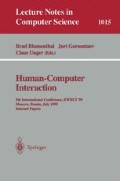Abstract
From a user-centered point of view, learning with hypermedia educational software is mainly a matter of navigation in a corpus of knowledge. However, although navigating obviously requires minimal competences in both computer interaction skills and domain knowledge, yet most current models of navigational support rely on a presupposed degree of proficiency in both domains. We suggest that every learner using a new navigational based learning system needs to be supported by an initial phase of orientation and initiation in both spaces of interface and domain contents. Activity metaphors seem to be a convenient way of supporting learner's cognitive transfer from familiar to unfamiliar domain in particular to help them structure their dynamic progress through the different phases of learning. We will refer to activity theory as a framework to structure both the support of the user navigation and the description of the learning process. As an overall navigational metaphor we will draw on a travel metaphor interpreted as a quest of objects by subjects (Greimas' semio-narrative theory). Considering that navigational issues in learning must evolve from a focus on navigation in the interface to navigation in the domain contents, we propose a three-phases navigational model specific for educational software. Each of the three phases call for different navigational support with Adaptive Hypermedia Systems (AHS) as one of them.
Preview
Unable to display preview. Download preview PDF.
References
Barker,P., (1993), Exploring Hypermedia, Book Manuscript, Interactive research group, The University of Teesside, Cleveland, TS13BA, UK.
Bourdoncle,B.,(1990), Une lecture du recit: l'approche semio-narrative, (in french), Ass. Voies livres, Lyon, France.
Bruillard,E.,De la Passardiere,B.,(1994), Hypermedias et education: des reperes, in Sciences et techniques educatives, V1, Nℴ1, pp 17–37.
Brusilovsky P.L., (1992), A Framework for Intelligent Lnowledge Sequencing and Task Sequencing, in Intelligent Tutoring Systems, proceedings of ITS'92, pp 499–506,Springer-Verlag.
Brusilovsky P.L.,Pesin L.,Zyryanov M., (1993), Towards an Adaptive Hypermedia Component for an Intelligent Learning Environment, Proceedings of EWHCI'93 East-West International Conference on Human-Computer Interaction, pp 27–38.
Caroll.J.M.,Mack,R.L.,Kellogg,W.A., (1988), Interface metaphors and User Interface Design, Chapter 3 in Handbook of Human-Computer Interaction, Holander (ed), Elsevier Science Publishers.
Cox,R.,Cumming,G.,(1990),The role of exploration-based learning in the development of expertise,Proceedings of Computers in Education,pp 359–364, Elsevier Science Publishers B.V.
Dillon,A.,McKnight,C.,Richardson,J.,(1990), Navigation in hypertext: a critical review of the concept, in proceedings of INTERACT'90, Elsevier Science Publisher B.V.
Elsom-Cook,M.,(1990), ECAL: Bridging the gap between CAL and ITS, M. Elsom-Cook and C. O'Malley, in Computers & Education, 15, p 69–81.
Greimas,A.J, Fontanille,J.,(1970,1983),Du sens: essais s emiotiques, Paris: Seuil, t1:1970,t23:1983.
Hammond,N.,Allinson,L., (1987), The travel Metaphor as design principle and training aid for navigating around complex systems. In Diaper and Winder (eds) People and Computers III, Cambridge Univ. Press.
Hammond,N.,Allinson,L., (1989), Extending Hypertext for learning: an Investigation of Access and Guidance Tools, in Sutcliffe and Macaulay (eds), People and Computers, Cambridge University Press.
Mulchings, G.A., Hall, W., Hammond, N.V., Kibby, M.R., McKnight, C., Riley, D., (1992), Authoring and Evaluation of Hypermedia for Education, Computers and Education, 18, pp 171–177.
Hutchins,E., (1987), Metaphors in Interface Design, ICS report 8703, Institute of cognitive science, UCSD, CA, USA
Kaptelinin.V., (1993), Activity Theory: Implications for Human Computer Interaction, in Human-Machine communication for educational Systems Design, NATO ASI Series 129, Springer-Verlag.
Laurillard,D., (1993),Rethinking University Teachinga framework for the effective use of educational technology,Routeledge, London, New york.
Leontiev,A.N.,(1974), The problem of Activity in Psychology, in Soviet Psychology Vol13, Nℴ2, 4–33.
Leontiev, A.N., (1972), Le developpment du psychisme, Trad. Fr: Paris, Eds. Sociales.
Linard,M., (1993), For a Knowing Subject in Models of Learning, in Communication & Cognition, V26, Nℴ 3/4, 291–320.
Linard,M.,Zeiliger,R., (1995), Designing an interface in an educational context: first steps to a principled approach, to appear at INTERACT'95, Lillehammer, Norway.
Norman,D., (1988), The psychology of everyday things, New York: basic book.
Nitsche-Ruhland,D.,(1994), Aknowledge-based Authoring System for Hypermedia-based Learning Environments, in proceedings of EWHCI'94, V2, Blumenthal, Gornostaev, Unger (Eds), ICSTI, Moscow.
Ricoeur, P., (1977), La semantique de l' action, Paris, Eds du CNRS
Rogers,Y.,Leiser,R.,Carr,D., (1988), Evaluating metaphors for use at the user-system interface, in Eurinfo'88, North Holland Publisher
Schütz, A., (1932), Le chercheur et le quotidien, Selection d'articles, Trad. Meridienis, Kluicksieck, Paris, 1987.
Serres,M., 1991, Le tiers-instruit, Collection Folio/Essais, Gallimard,Paris.
Subbotin,D.,(1994), User Interface of An Intelligent Navigation System, in proceedings of EWHCI'94, V2, Blumenthal, Gornostaev, Unger (Eds), ICSTI, Moscow.
Uzilevsky,G.,(1994), Ergosemiotics of User Interface Research and Design: Foundations, Objectives, Potential, in proceedings of EWHCI'94, V2, Blumenthal, Gornostaev, Unger (Eds), ICSTI, Moscow.
Vaanaanen,K., (1994), User Interfaces for Hypermedia: How to Find Good metaphors ?, in proceedings of CHI'94, ACM.
Von Cranach, Harre, (1972), The Analysis of Action, Recent Theoretical and Empirical Advance, Cambridge University Press.
Author information
Authors and Affiliations
Editor information
Rights and permissions
Copyright information
© 1995 Springer-Verlag Berlin Heidelberg
About this paper
Cite this paper
Linard, M., Zeiliger, R. (1995). Designing navigational support for educational software. In: Blumenthal, B., Gornostaev, J., Unger, C. (eds) Human-Computer Interaction. EWHCI 1995. Lecture Notes in Computer Science, vol 1015. Springer, Berlin, Heidelberg. https://doi.org/10.1007/3-540-60614-9_5
Download citation
DOI: https://doi.org/10.1007/3-540-60614-9_5
Published:
Publisher Name: Springer, Berlin, Heidelberg
Print ISBN: 978-3-540-60614-7
Online ISBN: 978-3-540-48484-4
eBook Packages: Springer Book Archive

